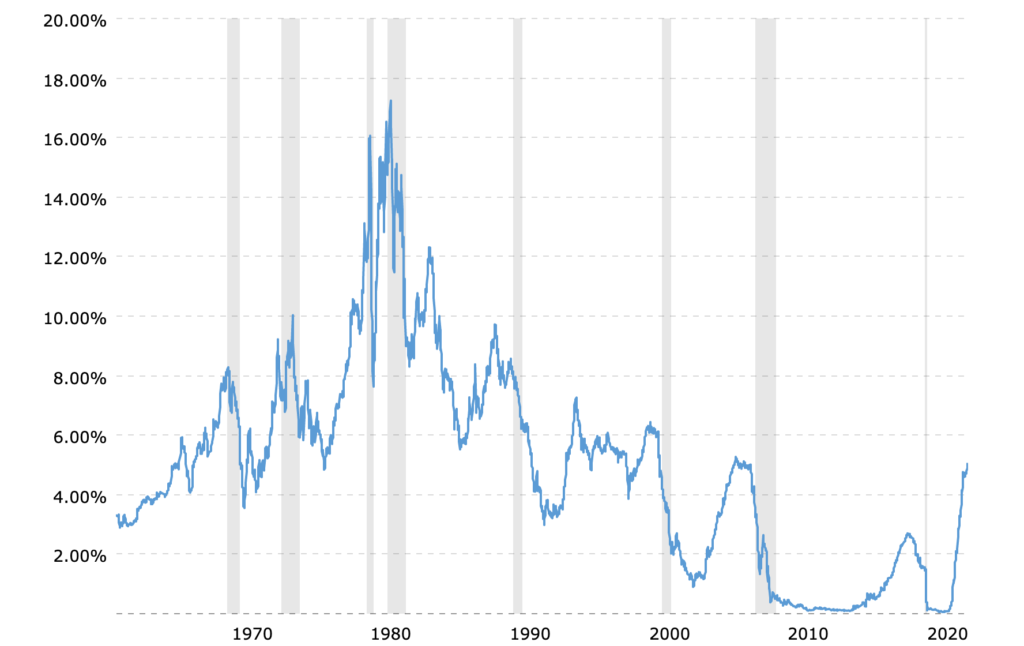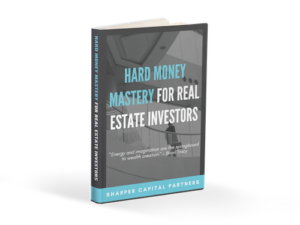As a hard money lender, I am often asked what I expect for the future of hard money loan interest rates. Truth is it is highly uncertain but, there are specific factors we are eying as the market continues to chart a unique path.
The key components that drive rates offered on hard money loans differ based on the capital stack of the lender.
Regardless, we monitor five factors when keeping a pulse on the market:
- The Federal Funds Rate
- Note Investor Risk Tolerance
- Alternative Investment Opportunities
- Supply and Demand of Real Estate
- Supply and Demand of Capital
The Federal Funds Rate
It would be an understatement to say that the federal funds rate didn’t drastically change the loan landscape of real estate finance starting in February of 2022.
For those who don’t know what the federal funds rate is, I like to quote these two definitions by Investopedia.
Formal Definition:
“The federal funds rate refers to the interest rate that banks charge other institutions for lending excess cash to them from their reserve balances on an overnight basis.”
– Investopedia
Practical Definition:
“An interest rate set by the Federal Reserve to indirectly manage interest rates, inflation, and unemployment.”
– Investopedia
The inflationary period from 2021 to 2022 was unlike anything we have seen since the “Great Stagflation” of the 1970s.
This has led the federal reserve to raise the federal funds rates 8 times with two more hikes likely in store in 2023.
So Why is the Federal Funds Rate such a big deal to Hard Money Lenders?
On a macroeconomic level, it affects the other four factors we are about to discuss:
(2) Note Investor Risk Tolerance
(3) Alternative Investment Opportunities
(4) Supply and Demand of Real Estate
(5) Supply and Demand of Capital
In addition, some lenders have chosen to source institutional capital as their primary capital source.
While this previously allowed institutional lenders to offer sticker rates lower than private capital lenders, those institutional lenders are either more expensive (and slower) or halted lending altogether.
Note Investor Risk Tolerance
Being a private lender, note investors are the bedrock of our capital base. Their risk tolerance ultimately determines the interest rates we can offer to our capital investors.
As of right now, an 8 – 10% annual percentage rate of return (APR) to capital investors has been the standard for most private lending shops.
However, some markets are proving more volatile and thus, risky. Greater risk tends to turn off capital investors. This leaves them in a wait and see type of pattern that mirrored the behavior of residential home buyers during the second half of 2022.
There are two ways private lending shops are mitigating their capital raise issues. They are offering higher rates of return to capital investors which usually results in higher interest rates to the real estate investors who use their loan products.
Or lending shops are upping their criteria requesting larger down payments, lower LTVs, and better borrower profiles (experience, credit, liquidity).
Alternative Investment Opportunities
In addition, it’s worth mentioning that hard money loans are just one investment product among many competing investment products.
For example, at the beginning of 2022 a 1-Year Treasury Bill was paying just 0.31% per year. At that time, a private note secured by real estate at a low LTV paying 8% was highly competitive with a risk premium of 7.69%.
As we sit here at the beginning of 2023, the same 1-Year Treasury Bill is paying 5% meanwhile private lending shops are still trying to raise capital by paying note investors 8 – 10%.
This puts the risk premium between 3% – 5% for note investors.
How much higher will interest rates go on Treasury Bills before it’s no longer worth the risk premium at current note investor rates? How will hard money lenders sourcing private capital react?
Supply and Demand of Real Estate
This is something that is market by market, asset type by asset type, right now. On a macro level though, more and more single family residential inventory is coming onto he market in the United States.
This should slow home price appreciation or even warrant depreciation in some markets, which is deterring current home speculators from pushing prices.
And from builders doing the same. While there are certainly more qualified authors to speculate on national housing markets, I’ll take a stab at speculating in the major Ohio Markets of Cincinnati, Dayton, Columbus, and Cleveland.
The rust belt of the United States tends to be behind the larger markets and less volatile in general. I foresee more housing to come onto the market, but little to no appreciation in 2023.
Homebuyers will accept new interest rates and agents and investors alike will have to reprice assets to their current comparable value instead of price setting.
Supply and Demand of Capital
One of the greatest threats to hard money lenders with a private capital base is the influx of business they are experiencing.
With institutional lenders pausing or closing funding altogether, it left many great real estate investors scrambling to fund their deals.
For example, in 2022 we closed 1 in every 24 loans we quoted. At the start of 2023, we are quoting more loans and closing roughly 1 in every 10 loans.
Leads are up, borrower quality is up, and deal quality is up.
What is the Future of Hard Money Lending?
Institutional capital will continue to prove more expensive than most private capital shops so long as interest rates stay where they are, which is not historically unusual.

This means that the rate at which private capital is lent will largely be determined by the risk tolerance of the note investors, the alternative investment opportunities they have, and the demand that is there for their capital.
We continue to stay bullish on the opportunities for both real estate investors and note investors to build wealth in this odd market.
And we do look forward to asset prices that are conducive to the financing options available to purchase those assets.
Until then… get creative with options like subject-to, seller financing, hard money, or raising your own private capital. If you have the deal, the capital will follow.


3 thoughts on “The Future of Hard Money Loan Interest Rates”
A great article offering solid information about private lending. I love the podcast and follow you guys. Hope to see more content in the future
Thanks, Glen! We are getting set up to start consistently releasing more podcast/youtube episodes for our real estate investment show. Hope to provide more value to you and the real estate community in general.
Great article! I really appreciate the clear and detailed insights you’ve provided on this topic. It’s always refreshing to read content that breaks things down so well, making it easy for readers to grasp even complex ideas. I also found the practical tips you’ve shared to be very helpful. Looking forward to more informative posts like this! Keep up the good work!